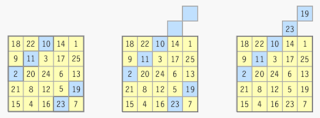Every one hundred days, as I track my diurnal age, a palindromic numbered day comes my way. Today is day 26562. Sometimes, like today's number, I create a post dedicated to the palindrome. I didn't do this for 26462 but prior to that I've posted about:
- 26362: Another Special Palindrome on June 6th 2021
- 26262: A Special Palindrome on February 26th 2021
- Palindromic Cyclops Numbers (in particular 26062) on August 10th 2020
- L-th Order Palindromes on January 24th 2019
- Lycrel Numbers on September 14th 2016
- Remembering Reverse and Add, Palindromes and Trajectories on June 22nd 2016
- 22, Reverse and Add on January 7th 2016
A046263 | Largest palindromic substring in \(5^n\). |
1, 5, 5, 5, 6, 5, 6, 8, 9, 9, 656, 828, 414, 22, 515, 757, 878, 939, 26562, 9, 9, 8, 101, 55, 464, 3223, 11611, 969, 252, 626, 515, 656, 696, 44, 26562, 7337, 51915, 75957, 797, 989, 949, 747, 787, 9739379, 86968, 707, 4224, 1001, 929, 646, 26562, 61616, 63336, ...
Here are the powers of \(n\) in which it appears up to 100:
- \(5^{18}\) = 3814697265625
- \(5^{34}\) = 582076609134674072265625
- \(5^{50}\) = 88817841970012523233890533447265625
- \(5^{66}\) = 13552527156068805425093160010874271392822265625
- \(5^{82}\) = 2067951531382569187178521730174907133914530277252197265625
- \(5^{98}\) = 315544362088404722164691426113114491869282574043609201908111572265625
A046394 | Palindromes with exactly 4 distinct prime factors. |
Palindrome Factorisation858 2 * 3 * 11 * 132002 2 * 7 * 11 * 132442 2 * 3 * 11 * 373003 3 * 7 * 11 * 134774 2 * 7 * 11 * 315005 5 * 7 * 11 * 135115 3 * 5 * 11 * 316666 2 * 3 * 11 * 10110101 3 * 7 * 13 * 3715351 3 * 7 * 17 * 4317871 3 * 7 * 23 * 3722422 2 * 3 * 37 * 10122722 2 * 3 * 7 * 54124242 2 * 17 * 23 * 3126562 2 * 3 * 19 * 23326962 2 * 13 * 17 * 6128482 2 * 3 * 47 * 10135853 3 * 17 * 19 * 3736363 3 * 17 * 23 * 31
PROPERTY THREE
A045960 | Palindromic even lucky numbers. |
2, 4, 6, 22, 44, 212, 262, 282, 434, 474, 646, 666, 818, 838, 868, 2442, 2662, 2772, 4884, 4994, 6666, 6886, 8118, 8338, 20202, 20402, 21012, 21812, 22322, 22422, 22922, 23332, 23532, 24042, 25652, 26162, 26262, 26562, 26762, 27372, 28682, 40204, 40804
Figure 1 reminds us what even lucky numbers are:
 |
| Figure 1: source |
PROPERTY FOUR
A317976 | a(n) = 2(a(n-1)+a(n-2)+a(n-3))-a(n-4) for n >= 4, with initial terms 0,0,1,0. |
The terms quickly increase in size and the initial terms are:
0, 0, 1, 0, 2, 6, 15, 46, 132, 380, 1101, 3180, 9190, 26562, 76763, 221850, 641160, 1852984, 5355225, 15476888, 44729034, 129269310, 373595239, 1079710278, 3120420620, 9018182964, 26063032485, 75323561860, 217689133998, 629133273722, 1818228906675, 5254779066930, 15186593360656, 43890069394800, 126844654738097
The generating function for these terms is:$$ \frac{x^2(1 - 2x) }{1 - 2x - 2x^2 - 2x^3 + x^4}$$PROPERTY FIVE
A261924 | Numbers that are the sum of two palindromes of the same length. |
- (16561, 10001)
- (16461, 10101)
- (16361, 10201)
- (16261, 10301)
- (16161, 10401)
- (16061, 10501)
- (15551, 11011)
- (15451, 11111)
- (15351, 11211)
- (15251, 11311)
- (15151, 11411)
- (15051, 11511)
- (14541, 12021)
- (14441, 12121)
- (14341, 12221)
- (14241, 12321)
- (14141, 12421)
- (14041, 12521)
- (13531, 13031)
- (13431, 13131)
- (13331, 13231)
 |
Figure 2 |



























